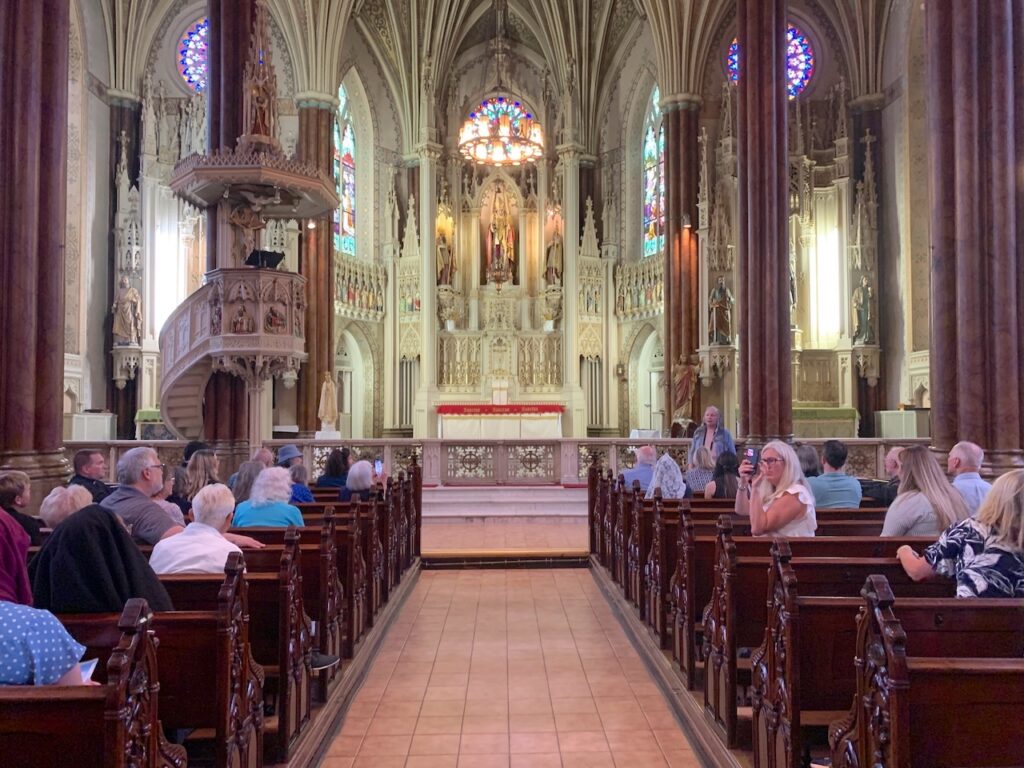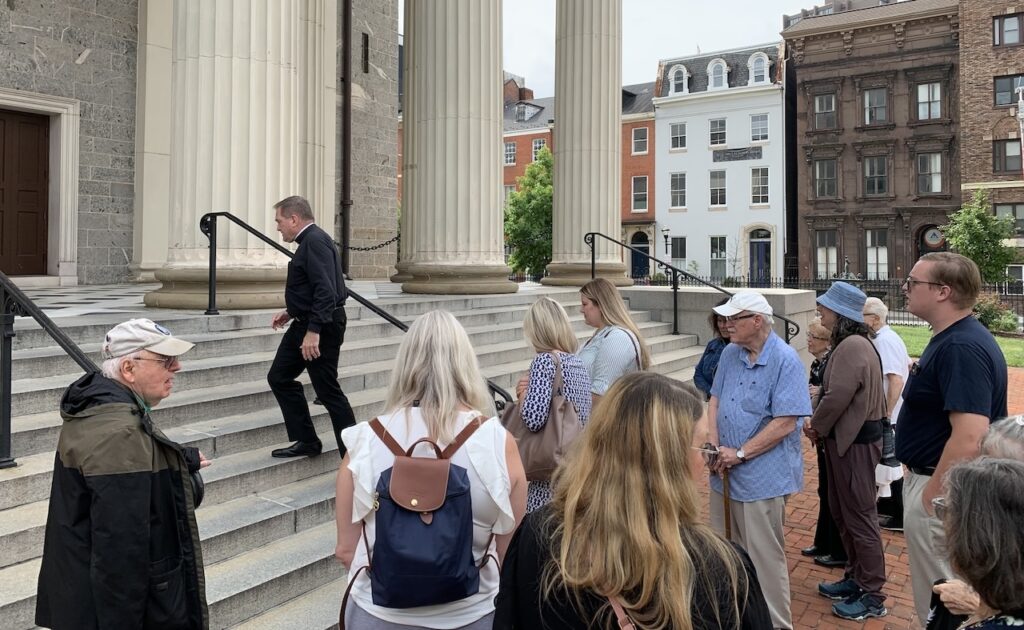Tens of thousands of Catholics gathered in Indianapolis for the first National Eucharistic Congress in 83 years. Catholics were invited to learn more about the Eucharist to renew and revive their faith. Some devotees spent the two months prior participating in Eucharistic pilgrimages, walking hundreds of miles from hubs in Minnesota, Connecticut, Texas, and California to join the historic five-day event. Locally, parishioners from St. Benedict, Richmond, made a pilgrimage to Baltimore on July 20 in solidarity with the national event.
“Since the year of Eucharistic Revival as a whole is all about rediscovering the transformative power of Jesus in the Eucharist, we thought Baltimore would be a great experience for our parishioners to learn about the early roots of the American Catholic Church,” explained Ben Fleser, director of evangelization and catechesis at St. Benedict.
As the first Catholic diocese established in the United States, Baltimore abounds in Catholic history. It is also the site of the country’s first cathedral, the Basilica of the Assumption. This cathedral was designed by the same architect of the U.S. Capitol building, and features similar neo-classical components, such as a massive dome and Ionic columns. The pilgrims from St. Benedict stopped there first to celebrate Mass.
“The Church identifies the Eucharist as the ‘source and summit of our faith, meaning everything we do, magisterially and otherwise, flows from the grace we receive through Christ’s body and blood,” said Fleser.
In addition to Mass, pilgrims were taken on a guided tour of the basilica, which contains many works of art and architecture, chapels, and a crypt.
Destiny Daughtrey has only been Catholic for a few months, but she quickly developed an affinity for Church traditions.
“I remember the first time I walked into a Catholic church and how right it felt,” she recalled. “Becoming Catholic has opened up my world to the beauty of being alive.”
The Blessed Sacrament holds a special place in her heart, so when she heard about the pilgrimage, she knew it was a journey she needed to take.
“I feel beyond blessed every time I take the Eucharist. The Eucharist nourishes my soul and provides me the spiritual strength to live a more purposeful life,” she said.
At one point, she wandered away from the group and ended up in the perpetual adoration room. It was overwhelming to be alone before the Blessed Sacrament, in the country’s first cathedral, where so many religious leaders have worshipped in the past.
“I had never felt what it was to be so up close and personal to the Blessed Sacrament,” she recalled. “Being in the basilica that was built for us to worship and kneeling in the same spot St. John Paul II did was a moving experience.”
The next stop was the National Shrine of St. Alphonsus Liguori. Built in 1841, the ornate neo-gothic church is dedicated to the patron saint of theologians. From its early days, this church was the site of outreach programs for immigrants building a new life in America. The shrine is also the home of the National Reparation Society, which aims to “make reparation for our sins, neglects, and offences as individuals, Catholics, and as a nation” according the shrine’s website.

“Stepping into the National Shrine of St. Alphonsus Liguori, my mouth fell open, and I’m pretty sure I audibly gasped,” noted pilgrim Jordan Hodge. “The sheer number of statues and the meticulous detail and love put into crafting and paying for them was all breathtaking.”
A self-described “cradle Catholic,” Hodge studied at Magdalen College of the Liberal Arts, where her love for the Eucharist grew with every visit to the dorm’s perpetual adoration chapel. “The Eucharist always makes me feel safe, seen, and loved, no matter what is going on in my life,” she said.
Hodge has visited holy sites in Italy and Poland before, but was equally inspired by what she found in Baltimore.
“I gained a greater appreciation for the stillness and comfort that rests in my heart and mind when I am near the Blessed Sacrament,” she said. “It doesn’t matter where you are, Jesus is there and he’s the same for all time and in all places.”
The pilgrims ended their journey at St. Mary’s Seminary and University. Built in 1791, it was the country’s first Catholic seminary, starting with just five clergy candidates from France. Blessed Father Michael McGivney, who founded the international fraternal service organization, the Knights of Columbus, studied there.
The seminary now boasts an expansive library, Ecumenical Institute open to people of all faiths, and Center for Continuing Formation for clergy and lay ecclesial ministers to grow in the faith.
“What struck me most was the dedication of the many faithful who dedicated countless resources of time, talent, and treasure to build, maintain, and support each site, and to know that I was praying in churches and chapels that were the result of much sacrifice on the part of my Catholic ancestors,” noted pilgrim Rosemary Utz.
Utz shared that while she was baptized Catholic, she had fallen away from the Church for a time until she was an adult. Since marrying and having children, faith has become an integral part of her life, and she was happy to mark this trip as her first pilgrimage. “The Blessed Sacrament is my lifeline, without which I would be completely lost,” she said.
Fleser hopes the pilgrims were inspired, not just by the buildings they visited, but by the people who built them, guided by the Holy Eucharist.
“I think it was good for our group to be reminded of our humble origins, and that these holy sites saw the works of saints laboring constantly in the vineyard of what seemed like unknown and unchartered territory for so long,” he said.
Fleser added, “However, these same saints, in all their struggles in service to God’s people, were sustained wholeheartedly on Jesus in the Eucharist.”

